

Tutorials — CodewithLilia. k12cs.org – K–12 Computer Science Framework. Untitled. CT Readings and Courses – ACTMAproject. Here are some readings and courses we have found helpful in defining what Computational Thinking (CT) is and how we might begin creating assessments and activities for integration into the classroom: Thinking About Computational Thinking–James J.
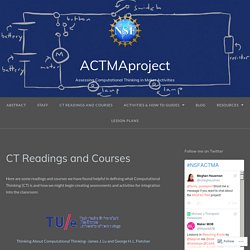
Lu and George H. L. Fletcher. Swift Playgrounds on the App Store. Everyone Can Code - Apple. Raspberry Pi - Teach, Learn, and Make with Raspberry Pi. Family Coding Day Session Resources - Beyond the Hour of Code. Family Coding Day is an annual event to get kids and parents, even grandparents, programming together.
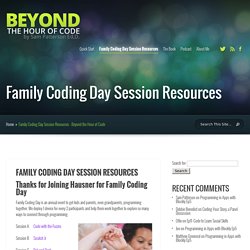
We deploy 1 device for every 2 participants and help them work together to explore so many ways to connect through programming. Session A Code with the Fuzzes Session B Scratch Jr Session C Dot and Dash Session D My Robotic Friends (Cup Stacking) BIG ANNOUNCEMENT: New Website Launches To Teach Coding To Teachers and Students. Podcast: Download | Embed I am excited to announce the launch of a website focused specifically on using programming in regular content area instruction.
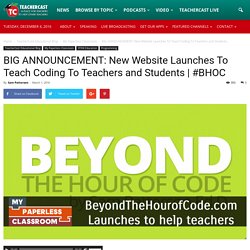
Since I began working as the technology teacher at Gideon Hausner Jewish Day School three years ago, I have been developing lessons and strategies for using programming and computational thinking in everyday lessons. BeyondTheHourofCode In March, Rowman and Littlefield will publish my first book “Programming in the Primary Grades: Beyond the Hour of Code” and the new website will host resources for this book as well as my new Podcast “Beyond the Hour of Code.”
The first 11 episodes of the New Podcast “Beyond the Hour of Code” preview the book content and get the conversation started about programming to learn in the K-5 classroom. ScratchJr - Beyond the Hour of Code. ScratchJr is the best tablet-based programming app for pre-readers of all time.

Getting students to the point where they are ScratchJr-comfortable only takes a lesson or two. Scratch the Dancing Cat: Two of the most important things students need to know is how to begin a program and how to tell the sprite to move. This lesson hits both of those points. The challenge for students is to design an awesome dance for Scratch the cat.
To create a dance, they will need to use the green flag event block (this triggers the program to begin when the green flag is clicked) combined with several of the blue movement pieces. ScratchJr - Home. Project GUTS. Welcome to Project GUTS. World Science U. Spurious Correlations.
Systems Thinking. Integrating Science and Engineering Practices into Assessments. Student Engagement and 20% Time: What We Can Learn from the Technology Sector : Chalkable. Few K-12 students have time to pursue independent inquiries during the school day, even when these questions might help them better understand the academic material presented.

This lack of time for additional research and making real world connections concerns K-12 educators, many of whom are seeking ways to increase engagement and provide school time for deep-thinking activities. Because there is an on-going need in the technology industry for ways to encourage innovation and creativity, educators are looking to this sector, exploring strategies used there to keep employees pursuing and developing new ideas. One tactic that has gained traction among educators is called “20% time.” What is 20% time? 20% time is a practice where personnel, usually knowledge workers, may spend one-fifth of their regular work time tinkering with their own projects. 20% time is not a formal program.
Math/Science/STEM. English Language Arts. Science fair project ideas, earth science, science technology. Sciencefun. Harvard STEM Teaching Videos. Posted on May 28th, 2013 by Mary Lord Looking for a way to make probability come to life in your multicultural math class and assess which students “got it?”
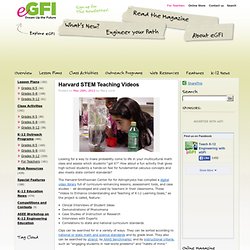
How about a fun activity that gives high-school students a hands-on feel for fundamental calculus concepts and also meets state content standards? The Harvard-Smithsonian Center for for Astrophysics has compiled a digital video library full of curriculum-enhancing lessons, assessment tools, and case studies - all developed and used by teachers in their classrooms. These “Videos to Enhance Understanding and Teaching of K-12 Learning Goals,” as the project is called, feature: • Clinical Interviews of Student Ideas • Demonstrations of Phenomena • Case Studies of Instruction or Research • Interviews with Experts • Correlations to state and national curriculum standards Clips can be searched for in a variety of ways.
The collection of 1,017 movies includes a range of topics. Among the “What’s the Point?” NSDL.org - National Science Digital Library. Next Generation Science Standards (Grades K-12) - Browse by Standards. NGSS/Science. Siemens STEM - Home. The K–12 Center at ETS: Invitational Research Symposium on Science Assessment. September 24–25, 2013 Washington, D.C.

This two-day research meeting brought together more than 250 leaders in science, education and assessment from academia, industry and government, including teams from some 30 states, to explore the skills and competencies called for in the Next Generation Science Standards (NGSS) and the measurement challenges and opportunities they pose. Commissioned papers were presented on the design of both summative tasks and formative systems that adhere to the vision of instruction underlying the NGSS. In addition, the policy and practice work ahead, including the difficult trade-offs to be made in the designs of comprehensive science assessment systems, were discussed. The closing two sessions were made available on the web in real time and the videos can be viewed below. View the Agenda (PDF) Summary Report by Rodger W.
Presentation Materials. National Energy Education Development Project. Hilliardscience. Online Resources. Explore the role chemistry has played in everyday life through biographies of those who have advanced our understanding, chemistry activities, and online resources.
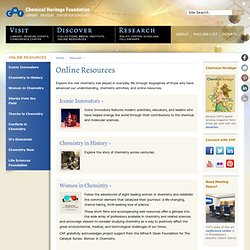
Iconic Innovators › Iconic Innovators features modern scientists, educators, and leaders who have helped change the world through their contributions to the chemical and molecular sciences. Download Free Science Activities, Find information on Workshops, Learn Chemistry Fundamentals. The Science & Entertainment Exchange. See some hilarious charts showing that correlation is not causation. The most powerful weapon that debaters wield against the unwary is causation: marijuana use leads to heroin addiction, pornography to rape, video games to mass murder, high consumption of margarine to divorces in Maine.
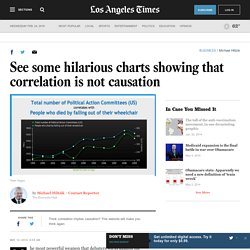
Whoops. The first three of these are common juxtapositions of parallel trend lines, and the fourth is from the website Spurious Correlations, the work of a Harvard Law School student named Tyler Vigen. CS in Science. Code.org has partnered with the award-winning Project GUTS (Growing Up Thinking Scientifically) to deliver a middle school science program consisting of four instructional modules and professional development for the introduction of computer science concepts into science classrooms within the context of modeling and simulation.

The goal of the program is to situate computer science practices and concepts within the context of life, physical, and earth sciences, and to prepare students to pursue formal, year-long courses in computer science during high school. CS in Science is based on a crosswalk identifying areas of overlap between the NGSS and Computer Science Teachers Association K-12 Computer Science Standards. Download a brief or full description.
Videos Curriculum Documents. Manoa.hawaii.edu/ExploringOurFluidEarth. According to the National Research Council’s Framework for K–12 Science Education, crosscutting concepts bridge the boundaries of science and engineering domains. These concepts provide students with an organizational framework for understanding and connecting scientific and engineering knowledge across disciplines and school years. The Framework suggests that these crosscutting concepts be explicitly taught and used in classroom instruction to organize teaching and learning in science and engineering. In Exploring Our Fluid Earth, crosscutting concepts are aligned with Special Features, Activities, or Question Sets.
Crosscutting concepts are also embedded in Performance Expectations, which are aligned at the topic level. For example, this curriculum addresses the crosscutting concept Cause and Effect: Mechanism and Explanation through the activity Density Bags (Fig. 2.12). Welcome! NASA Wavelength Digital Library. Scientific teaching and engaged learning: building capacity for expert thinking. Matter and Its Properties. Raspberry Pi Project: A Wolfram Engine on Every Raspberry Pi. An Elementary Introduction to the Wolfram Language by Stephen Wolfram. The Wolfram Language represents a major advance in programming languages that makes leading-edge computation accessible to everyone. Wolfram Cloud: Building intelligence into a new kind of cloud.
Programming Lab: Computational Thinking Starts Here. Language for Knowledge-Based Programming. LiveCode in Education. Course Materials – Age 14 to 16 Based on the Scottish National level 4 and covering the complete syllabus. These notes are editable in a variety of formats and suitable to be adapted as a general introduction to programming for students anywhere in the world within this age group.
These course notes have generously been provided by Steven Whyte, Computing Studies teacher at Gracemount High School, Edinburgh. Download Course Materials. Alice.org. Learn code. Learn math. ANSYS - Simulation Driven Product Development. Free Simulation Software for Education. Project GUTS. CS is Fun. Untitled. Coding for Kids. CodeableCrafts. Robiis: The Robot Programming Game! Looking Glass. Lesson Plans for Floors — Pixel Press. Scratch Cards. Made with Code. Coding. Coding Bootcamp After College. Meet the Experts Shawn Drost, Co-Founder,Hack Reactor Michele Farquharson, Director of Education,Betamore Academy. Exploring Computer Science.
Girls Who Code Girls Who Code works to close the gender gap in technology. Our free programs educate, inspire, and equip girls to pursue opportunities in technology. CodeMonkey. Coding in School & Computer Science. Bootstrap. Courses - Tynker. Rocket21. Secondary Education Software for High Schools & Middle Schools. Computer Science Unplugged. Hopscotch - Coding for kids.
Mozilla Thimble. Search. Hopscotch - Coding for kids. Gamestar Mechanic. Computer Science Unplugged. MIT STEP. Gamestar Mechanic. Stencyl. Build Worlds If you're used to graphics editors like Photoshop, you'll feel right at home in the Scene Designer.
Familiar features, such as a selection tool, zooming, grid-snapping and flood fill, will help you quickly craft complex worlds out of Actors, Tiles and Terrain. Scratch - Imagine, Program, Share. Minecraft Modding Classes - ThoughtSTEM. Beneath the world of Minecraft is an equally fascinating world of hardware and software -- built upon 150 years of computer science history.
This class introduces students to this new world by exploring client/server architectures, network security, operating systems, and computer programming. STEP. Welcome to EtoysIllinois.org!